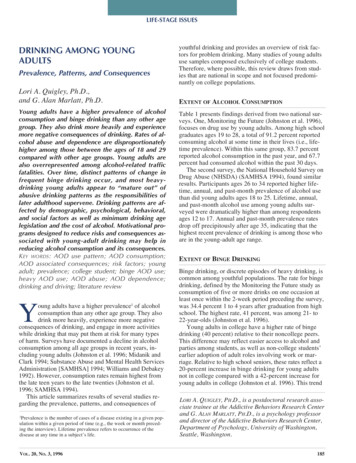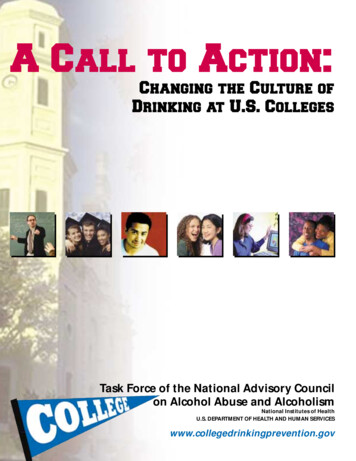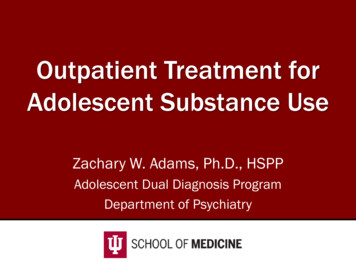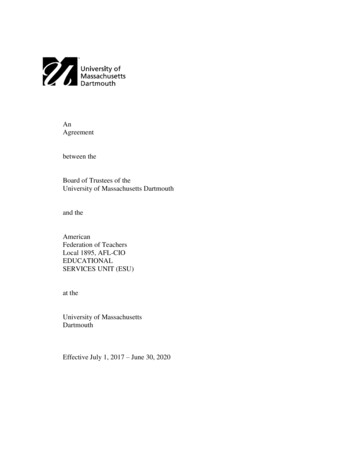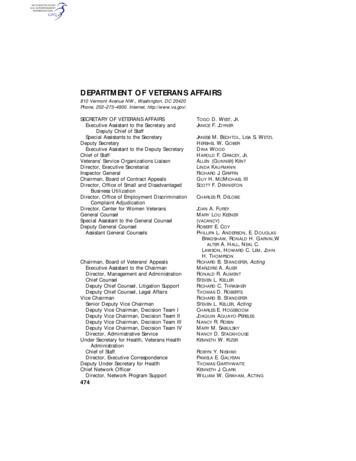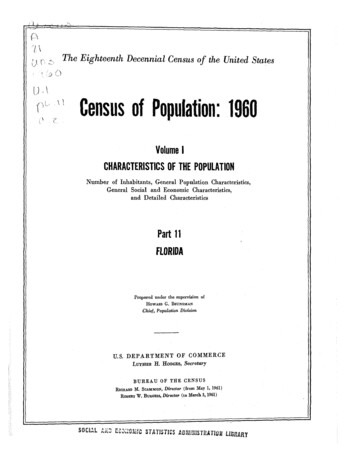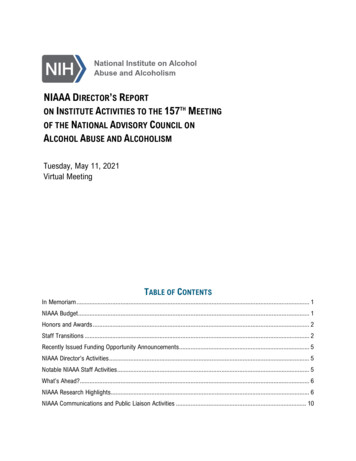
Transcription
NIAAA DIRECTOR’S REPORTON INSTITUTE ACTIVITIES TO THE 157TH MEETINGOF THE NATIONAL ADVISORY COUNCIL ONALCOHOL ABUSE AND ALCOHOLISMTuesday, May 11, 2021Virtual MeetingTABLE OF CONTENTSIn Memoriam . 1NIAAA Budget . 1Honors and Awards . 2Staff Transitions . 2Recently Issued Funding Opportunity Announcements . 5NIAAA Director’s Activities . 5Notable NIAAA Staff Activities . 5What’s Ahead? . 6NIAAA Research Highlights. 6NIAAA Communications and Public Liaison Activities . 10
IN MEMORIAMMary Jeanne Kreek, M.D., passed away in March 2021. Dr. Kreek contributedenormously to the study of addiction, and her work has been crucial in eroding thestigma that still surrounds addiction and its treatment. Her seminal contributionsinclude her work with Drs. Vincent Dole and Marie Nyswander helping to develop thefirst medication for opioid use disorder, methadone, and contributing to thedevelopment of another medication for opioid use disorder, buprenorphine. She alsoidentified injection drug use as the second major risk behavior for HIV transmission,and she contributed significantly to our basic research understanding of theneurobiology of addiction. Dr. Kreek received many awards and honors during her illustrious career,including the Association for Multidisciplinary Education and Research in Substance Use and AddictionBetty Ford Award, the National Institute on Drug Abuse Lifetime Science Award, the American Academy ofAddiction Psychiatry’s Founders’ Award, and the Nathan B. Eddy Memorial Award for Lifetime Excellencein Drug Abuse Research from the College on Problems of Drug Dependence.Emanuel (Manny) Rubin, M.D., passed away in February 2021. Dr. Rubin was aninternationally recognized academic pathologist with an all-encompassing knowledgeof molecular pathology and investigator of the alcohol-induced pathogenesis of heartand liver disease. Dr. Rubin’s seminal contributions to the study of alcohol’s effects onthe body include providing definitive evidence that alcohol toxicity, rather than poornutrition, was responsible for organ damage related to alcohol misuse (a collaborationwith Dr. Charles Lieber) and identifying mitochondrial dysfunction in the heart andliver as the target of alcohol toxicity. Dr. Rubin established an Alcohol ResearchCenter, first at Hahnemann University, then at Thomas Jefferson University, Philadelphia, Pennsylvania.Dr. Rubin’s achievements have been recognized through numerous honors, including the 2015 LifetimeAchievement Award from the Research Society on Alcoholism and the Gold-Headed Cane Award from theAmerican Society of Investigative Pathology.1
NIAAA BUDGETFiscal Year (FY) 2021On December 27, 2020, the President signed the H.R. 133 - Consolidated Appropriations Act, 2021. TheNational Institutes of Health (NIH) received a total of 42.9 billion, 1.25 billion above the FY 20 enactedlevel. NIH also received supplemental funding of 1.25 billion through FY 2024 from the coronavirussupplemental appropriations included in H.R. 133. Additionally, funding includes allocations for the Helpingto End Addiction Long-term (HEAL) Initiative, the 21st Century Cures Act, Brain Research throughAdvancing Innovative Neurotechnologies (BRAIN) Initiative, and research on influenza. The bill provides ageneral increase to NIH Institutes and Centers, and it continues to support the Gabriella Miller Kids FirstAct pediatric research initiative.The FY 21 appropriation for NIAAA provides 554.9 million, which represents an 8.2 million (1.8 percent)increase over the FY 20 actual budget level. At this time, NIAAA estimates it will support a total of 699research project grants in FY 2021.FY 2022The preparation of the FY 22 President’s Budget is underway as of April 2021.HONORS AND AWARDSDr. Shana Augustin, Research Fellow in the Laboratory for Integrative Neuroscience, received a HenryGrass, M.D., Rising Stars in Neuroscience Achievement Award from The Grass Foundation.STAFF TRANSITIONSNew StaffShera Smith joined NIAAA as an Extramural Support Assistant in the Review Branch,Office of Extramural Activities. Mrs. Smith is a military spouse and has worked for theU.S. Army since 2007. Prior to joining NIAAA, she was the lead technician at MoncriefArmy Health Clinic, Department of the Army, Columbia, South Carolina, and worked as aHuman Resource Specialist. She has a bachelor’s degree in health careadministration/management and master’s degree in health resource management.2
Khushbu Agarwal, Ph.D., Postdoctoral Visiting Fellow, joined the Section of SensoryScience and Metabolism, Division of Intramural Clinical and Biological Research(DIBCR). She was previously a Postdoctoral Visiting Fellow at the National Institute ofNursing Research. Dr. Agarwal earned her doctorate in 2017 from the Institute ofMedical Sciences, New Delhi, India, in the field of nuclear magnetic resonanceimaging and spectroscopy. Dr. Agarwal will apply her expertise and skills inneuroimaging techniques and data analysis to the study of the relationship betweenhedonic pathways, sensory systems, and disease. She is interested in the interplaybetween metabolic disorders, sensory-related pathways, and brain diseases—particularly alcohol andsubstance use disorders.Abhishek Basu, Ph.D., joined the Section on Fibrotic Disorders, DIBCR, as aPostdoctoral Visiting Fellow. Dr. Basu received his doctorate in pharmacy fromJadavpur University, Kolkata, India, in 2017. Dr. Basu’s work in the Section of FibroticDisorders will focus on scientific projects exploring the molecular mechanismsinvolved in the development of pulmonary fibrosis of various etiology, includingalcohol-induced lung injury, and testing novel therapeutic agents designed in-houseusing animal models of fibrotic disorders.Yukun Guan, Ph.D., joined the Laboratory of Liver Diseases, DIBCR, as aPostdoctoral Visiting Fellow. Dr. Guan earned his bachelor’s in biology fromLanzhou University, and doctorate in cell biology from Beijing University in China.He joined NIH as a Postdoctoral Visiting Fellow at the National Cancer Institute in2017. In the Laboratory of Liver Diseases, Dr. Guan will study the roles of innateimmune cells and cytokines in liver injury, regeneration, and cancer. Particularly, hewill study the molecular mechanisms by which interleukin-22 receptor expressionin hepatocytes and other epithelial cells are regulated, and the roles of various subsets of macrophages incontrolling liver metabolism, injury, and regeneration.Markos Woldeyohannes, M.D., Ph.D., Postdoctoral Visiting Fellow, joined theSection of Sensory Science and Metabolism, DIBCR. Dr. Woldeyohannes came toNIH as a fellow under the African Postdoctoral Training Initiative, previously workingat the National Institute of Nursing Research. At NIAAA, Dr. Woldeyohannes’research will focus on the intersection of nutrition and psychiatry. Dr.Woldeyohannes received his medical degree in 2002 from the Faculty of MedicalSciences, Jimma University, Ethiopia, and his doctorate in 2016, from the Faculty ofScience, University of Copenhagen, Denmark.3
Internal TransitionsResat Cinar, Ph.D., transitioned to Tenure Track Investigator and Acting Chief forthe Section on Fibrotic Disorders, DICBR. The mission of the section is tounderstand the cellular and molecular mechanisms involved in the development andprogression of fibrosis, to explore novel therapeutic targets, and to developeffective pharmacotherapies for fibrotic disorders of different etiologies, includingalcohol use disorder. Since joining NIAAA in 2009, Dr. Cinar has held appointmentsas Postdoctoral Visiting Fellow, Research Fellow, and Staff Scientist in DICBR.Malliga Iyer, Ph.D., transitioned to Tenure Track Investigator and Acting Chief forthe Section on Medicinal Chemistry, DICBR. The mission of the section is to developselective probes and drug-like molecules to enable the study of molecularmechanisms in alcohol-associated diseases. Dr. Iyer established a medicinalchemistry core in her previous role as Research Fellow in the NIAAA Office of theScientific Director, a position in which she was the driving force in the creativedesign of a new class of peripherally restricted, dual-target CB1 receptorantagonists/inverse agonists as potential therapy for various forms of tissue fibrosis, including liverfibrosis related to alcohol misuse.Janos Paloczi, Ph.D., transitioned from Postdoctoral Visiting Fellow to ResearchFellow in the Laboratory on Cardiovascular Physiology Tissue Injury, DIBCR. Dr.Paloczi currently is a key investigator in several ongoing research projectsinvestigating the synergistic detrimental cardiovascular consequences of bingedrinking and synthetic cannabinoid consumption. As a Research Fellow, Dr. Palocziwill also explore the role of gut microbiome in acute alcohol-induced hemodynamiceffects, the role of acetaldehyde in the hemodynamic effects of alcohol, and thecontribution of central and peripheral CB1R signaling in alcohol use disorder-induced acute cardiovasculareffects. Prior to joining NIAAA as a Postdoctoral Visiting Fellow, Dr. Paloczi earned his doctorate intheoretical medical sciences in 2015 at the University of Szeged, Szeged, Hungary.Departing StaffEmily Buzgierski, Administrative Officer, departed the Administrative Services Branch, Office of ResourceManagement, for a new position with the Division of Management Services, Center for Scientific Review,where she will serve as an Administrative Officer.Carlos Gomez, Administrative Officer, departed NIAAA to begin a new opportunity serving as anAdministrative Officer for the NIH Office of Extramural Research, Strategic Management and ContractsOffice, where he will be responsible for providing administrative duties supporting staff.4
RECENTLY ISSUED FUNDING OPPORTUNITY ANNOUNCEMENTSNIAAA DIRECTOR’S ACTIVITIESNIAAA Director George F. Koob, Ph.D., gave the following virtual presentations between January 1 andMarch 31, 2021: “Alcohol Use Disorder During the COVID-19 Pandemic” for the Johns Hopkins Delivery of EarlyLiver Transplant for Alcoholic Hepatitis (DELTA) Center for Alcohol Research Symposium,Alcoholic Hepatitis: Pathogenesis, Treatment, and Challenge, on January 15, 2021“NIAAA Update” for the Community Anti-Drug Coalitions of America National Leadership Forum onFebruary 1, 2021“Opioid Addiction: Opponent Process, Hyperkatifeia, and Negative Reinforcement” for theUniversity of California San Francisco Pain and Addiction Research Center International Pain andAddiction Conference on March 13, 2021“Addiction and Loss of Control: Hyperkatifeia, Negative Reinforcement, and the Dark Side ofAddiction” for the Center for Academic Research and Training in Anthropogeny (CARTA)Symposium, Altered States of the Human Mind: Implications for Anthropogeny, on March 13,2021“NIAAA Update: The COVID-19 Pandemic and Beyond” for the Collaborative Perspectives onAddiction Conference (American Psychological Association Division 50, Society of AddictionPsychology) on March 18, 2021NOTABLE NIAAA STAFF ACTIVITIESDr. Judith Arroyo participated in a webinar about NIH career development awards for the ResearchSociety on Alcoholism Emerging Scholars Seminar Series on February 26, 2021.Dr. Kendall Bryant presented an overview of NIH and NIAAA HIV and alcohol objectives and engaged inmultiple mentoring activities at a Uganda Russia Boston Alcohol Network for Alcohol ResearchCollaboration on HIV/AIDS (URBAN ARCH; Boston University) trainee event held virtually on March 17,2021, in lieu of a 2021 URBAN ARCH annual meeting. The URBAN ARCH event offered opportunities fortrainees to network with senior investigators, including a meet-and-greet session followed by drop-inoffice hour sessions.Dr. Mark Egli participated in a virtual expert panel for the University of Toronto School Neuroscience BrainBee Club. The discussion between addiction experts and high school students focused on views regardingthe neurobiology, psychology, clinical care aspects, and public health aspects of addiction. The discussionwas held March 10, 2021.Dr. Laura Kwako co-chaired a virtual session on NIH funding opportunities at the Addiction HealthServices Research Conference on March 15, 2021. At the same conference, Dr. Mariela Shirley led abreakout session on early career and training funding opportunities.5
Dr. Dominique Lorang-Leins, Dr. Jenica Patterson, and Greg Roa were involved in the development of avideo for Virtual Brain Awareness Day held on March 19, 2021 and hosted by the National Museum ofHealth and Medicine as part of Brain Awareness Week.Dr. John Matochik co-chaired the National Institute on Drug Abuse-NIAAA Frontiers in Addiction ResearchMini-Convention, which was held as a virtual two-day event on January 7 and 8, 2021. He was also thechair for the Early Career Investigator Showcase at the event.WHAT’S AHEAD?The 16th Annual NIH Pain Consortium Symposium, Pain and Pandemics: Challenges and Opportunities inthe Current Social and Healthcare Climate, will be held May 24 and 25, 2021, in an all-virtual format.Topics will include the impact of social determinants of health on chronic pain and pain management, theimpact of COVID-19 on chronic pain and co-morbidities, and interventions for reducing health disparities.Members of the extramural scientific community, the NIH scientific community, health care providers, andthe public are invited to attend. View the agenda and registration information at:https://www.painconsortium.nih.gov/The 7th Annual Brain Research through Advancing Innovative Neurotechnologies (BRAIN) InitiativeInvestigators Meeting will be held virtually June 15-17, 2021. The meeting will convene BRAIN Initiativeawardees, staff, and leadership from the contributing federal agencies (NIH, National Science Foundation,Defense Advanced Research Projects Agency, Intelligence Advanced Research Projects Agency, and U.S.Food and Drug Administration), plus representatives and investigators from participating non-federalorganizations, and members of the media, public, and Congress. The purpose of this open BRAIN Initiativemeeting is to provide a forum for sharing scientific developments and new directions and identifying areasfor collaboration and research coordination. View meeting information at:https://www.brainmeeting2021.com/.NIAAA RESEARCH HIGHLIGHTSBRAIN ETHANOL METABOLISM BY ASTROCYTIC ALDH2 DRIVES THE BEHAVIORAL EFFECTS OF ETHANOL INTOXICATIONSignificance: Hepatic aldehyde dehydrogenase 2 (ALDH2) is a key enzyme that converts acetaldehyde, aby-product of alcohol metabolism, to acetate, a compound shown to contribute to the behavioral effects ofalcohol in animal models. ALDH2 is thought to be present in the brain, at much lower levels than the liver,and little is known about the potential involvement of brain ALDH2 in alcohol metabolism. In the currentstudy, investigators identified the presence of ALDH2 in astrocytes of the cerebellum in humans and mice.They also demonstrated that astrocytic ALDH2-mediated the production of acetate. Astrocytic ALDH2 wasfound to mediate both alcohol- and acetate-induced cellular and behavioral effects, including impairmentof balance and coordination skills, via GABAergic signaling. The findings pave the way for additionalresearch on astrocytic ALDH2 as a potential target for the pathophysiology of alcohol use disorder.Alcohol is among the most widely used psychoactive substances worldwide. Ethanol metabolites such asacetate, thought to be primarily the result of ethanol breakdown by hepatic aldehyde dehydrogenase 2(ALDH2), contribute to alcohol's behavioural effects and alcoholism. Here, we show that ALDH2 isexpressed in astrocytes in the mouse cerebellum and that ethanol metabolism by astrocytic ALDH2mediates behavioural effects associated with ethanol intoxication. We show that ALDH2 is expressed in6
astrocytes in specific brain regions and that astrocytic, but not hepatocytic, ALDH2 is required to produceethanol-derived acetate in the mouse cerebellum. Cerebellar astrocytic ALDH2 mediates low-dose ethanolinduced elevation of GABA levels, enhancement of tonic inhibition and impairment of balance andcoordination skills. Thus, astrocytic ALDH2 controls the production, cellular and behavioural effects ofalcohol metabolites in a brain-region-specific manner. Our data indicate that astrocytic ALDH2 is animportant, but previously under-recognized, target in the brain to alter alcohol pharmacokinetics andpotentially treat alcohol use disorder. (Jin S, Cao Q, Yang F, Zhu H, Xu S, Chen Q, Wang Z, Lin Y, Cinar R,Pawlosky RJ, Zhang Y, Xiong W, Gao B, Koob GF, Lovinger DM, Zhang L. Nat Metab. 2021 Mar;3(3):337351. doi: 10.1038/s42255-021-00357-z.)TRAIL MEDIATES NEURONAL DEATH IN AUD: A LINK BETWEEN NEUROINFLAMMATION AND NEURODEGENERATIONSignificance: Analysis of postmortem human cortex of individuals diagnosed with alcohol use disorder(AUD) implicated the induction of tumor necrosis factor (TNF)-related apoptosis-inducing ligand (TRAIL)apoptotic death receptors as a mediator of neuronal death. TRAIL acts through the Toll-like receptor 7(TLR7) neuroimmune signaling pathway and its endogenous ligand, microRNA let-7b. The findings alsoindicated that chronic binge levels of ethanol exposure in mice induced the expression of neuronal TLR7,increased expression of let-7b, and enhanced TLR7-mediated cell death responses through TRAIL,mimicking the findings in human AUD cortex. Additionally, inhibition of TLR7 and let-7b blocked ethanolinduced neuronal death. Together, these findings suggest that TRAIL is a mediator of neuronal deathinvolving TLR7 activation in AUD.Although the cause of progressive neurodegeneration is often unclear, neuronal death can occur throughseveral mechanisms. In conditions such as Alzheimer's or alcohol use disorder (AUD), Toll-like receptor(TLR) induction is observed with neurodegeneration. However, links between TLR activation andneurodegeneration are lacking. We report a role of apoptotic neuronal death in AUD through TLR7mediated induction of death receptor signaling. In postmortem human cortex, a two-fold increase inapoptotic terminal deoxynucleotidyl transferase dUTP nick end labeling (TUNEL) staining in neurons wasfound in AUD versus controls. This occurred with the increased expression of TLR7 and tumor necrosisfactor (TNF)-related apoptosis-inducing ligand (TRAIL) death receptors. Binge ethanol treatment inC57BL/6 mice increased TLR7 and induced neuronal apoptosis in cortical regions that was blocked byTLR7 antagonism. Mechanistic studies in primary organotypic brain slice culture (OBSC) found that theinhibition of TLR7 and its endogenous ligand let-7b blocked ethanol-induced neuronal cell death. Both IMQand ethanol induced the expression of TRAIL and its death receptor. In addition, TRAIL-neutralizingmonoclonal antibodies blocked both imiquimod (IMQ) and ethanol induced neuronal death. These findingsimplicate TRAIL as a mediator of neuronal apoptosis downstream of TLR7 activation. TLR7 and neuronalapoptosis are implicated in other neurodegenerative diseases, including Alzheimer's disease. Therefore,TRAIL may represent a therapeutic target to slow neurodegeneration in multiple diseases. (Qin L, Zou J,Barnett A, Vetreno RP, Crews FT, Coleman Jr LG. Int J Mol Sci. 2021 Mar 4;22(5):2547. doi:10.3390/ijms22052547.)DIAGNOSTIC AND PROGNOSTIC SIGNIFICANCE OF COMPLEMENT IN PATIENTS WITH ALCOHOL-ASSOCIATED HEPATITISSignificance: Researchers assessed whether complement proteins, which have a critical role in the innateimmune system, are correlated to alcohol‐associated hepatitis (AH) disease status and progression bycomparing plasma samples of participants diagnosed with either moderate or severe AH to healthycontrols. The results demonstrated that complement factor I (CFI) and soluble complement 5b‐9 (sC5b9)7
were decreased in non-survivor AH participants and predicted 90‐day mortality. The findings indicate thatindependent complement pathways may differentially contribute to AH severity and that multiplecomplement factors, including CFI and sC5b9, may be useful biomarkers for diagnosing AH and predictingdisease severity.Background and aims: Given the lack of effective therapies and high mortality in acute alcohol-associatedhepatitis (AH), it is important to develop rationally designed biomarkers for effective disease management.Complement, a critical component of the innate immune system, contributes to uncontrolled inflammatoryresponses leading to liver injury, but is also involved in hepatic regeneration. Here, we investigatedwhether a panel of complement proteins and activation products would provide useful biomarkers forseverity of AH and aid in predicting 90-day mortality. Approach and results: Plasma samples collected attime of diagnosis from 254 patients with moderate and severe AH recruited from four medical centers and31 healthy persons were used to quantify complement proteins by enzyme-linked immunosorbent assayand Luminex arrays. Components of the classical and lectin pathways, including complement factors C2,C4b, and C4d, as well as complement factor I (CFI) and C5, were reduced in AH patients compared tohealthy persons. In contrast, components of the alternative pathway, including complement factor Ba(CFBa) and factor D (CFD), were increased. Markers of complement activation were also differentiallyevident, with C5a increased and the soluble terminal complement complex (sC5b9) decreased in AH.Mannose-binding lectin, C4b, CFI, C5, and sC5b9 were negatively correlated with Model for End-StageLiver Disease score, whereas CFBa and CFD were positively associated with disease severity. Lower CFIand sC5b9 were associated with increased 90-day mortality in AH. Conclusions: Taken together, thesedata indicate that AH is associated with a profound disruption of complement. Inclusion of complement,especially CFI and sC5b9, along with other laboratory indicators, could improve diagnostic and prognosticindications of disease severity and risk of mortality for AH patients. (Fan X, McCullough RL, Huang E,Bellar A, Kim A, Poulsen KL, McClain CJ, Mitchell M, McCullough AJ, Radaeva S, Barton B, Szabo G,Dasarathy S, Rotroff DM, Nagy LE. Hepatology. 2021 Mar;73(3):983-997. doi: 10.1002/hep.31419.)EVALUATION OF THE ADDICTIONS NEUROCLINICAL ASSESSMENT (ANA) FRAMEWORK THROUGH DEEP PHENOTYPING OFPROBLEM DRINKERSSignificance: The Addictions Neuroclinical Assessment (ANA) is a neuroscience-informed novel frameworkfor addictive disorders that captures three functional domains of the addiction cycle: incentive salience,negative emotionality, and executive function. Investigators conducted an independent test of the ANAframework using a large clinical sample of participants across a range of alcohol misuse phenotypes.Participants completed a battery of well-validated scales and behavioral tasks of alcohol use and misuse,mood, attention, and impulsivity, which were analyzed to derive a factor solution that explainedbiobehavioral variation in the sample. Results implicated four functional domains that complemented andextended the ANA domains: negative alcohol-related consequences, incentive salience, negativeemotionality, and executive function. Of note, ANA domains were found to be distinct from latent factorsthat reflect alcohol use disorder (AUD) phenomenology (i.e., alcohol-related consequences). This studylargely supports and extends the ANA framework for understanding the heterogeneity in AUD.Background: To advance the development of a neuroscience-informed understanding of alcohol usedisorder (AUD) through the Addictions Neuroclinical Assessment (ANA) framework, the present studyreports on deep phenotyping of a large sample of problem drinkers. Methods: Participants (n 1679)were primarily heavy drinkers with and without AUD, who completed a phenotypic battery of well-validatedscales and behavioral measures of alcohol use and problems, mood, attention, and impulsivity. These8
scales were subjected to sequential factor analytic work in order to derive a factor solution that explainsbiobehavioral variation in the sample. To assess the construct validity of the resulting factor solution,scores on each factor were associated with demographic and clinical indicators. Results: Factor analysistechniques using indicators of alcohol use and problems, mood, attention, and impulsivity implicated fourfunctional domains that compliment and extend the proposed ANA domains: negative alcohol-relatedconsequences, incentive salience, negative emotionality, and executive function. Demographic and clinicalvariables significantly predicted scores on all ANA domains. Conclusions: This study provides anindependent test of the recently proposed neuroscience-based ANA framework. Results largely supportthe novel approach in identifying four core constructs in problem drinkers. Future studies can deepen ourunderstanding of how these domains are relevant to AUD by incorporating biomarkers. (Nieto SJ, GrodinEN, Green R, Ray LA. Drug Alcohol Depend. 2021 Apr 1;221:108603. doi:10.1016/j.drugalcdep.2021.108603.)CHANGES IN YOUNG ADULTS' ALCOHOL AND MARIJUANA USE, NORMS, AND MOTIVES FROM BEFORE TO DURING THECOVID-19 PANDEMICSignificance: Researchers collected and analyzed data from a community sample of young adults (medianage 25) from Washington state to assess whether alcohol and marijuana use rates changed during theCOVID‐19 pandemic. Data were collected prior to the pandemic (January 2020) and again following theimplementation of major physical/social distancing restrictions (April/May 2020). The results indicated anincrease in the frequency of alcohol consumption with no significant change in the total amount of alcoholconsumed on average. No variation in marijuana use was identified. Young adults overestimated peeralcohol/marijuana use compared to actual rates, but correctly perceived an increase in alcohol usefrequency. Findings also indicated that motives for alcohol and marijuana use changed. For alcohol usemotives, in particular, there was a significant increase in depression coping motives and significantdecreases in social, enhancement, and conformity motives.Purpose: Alongside the SARS-CoV-2 virus, the COVID-19 pandemic is associated with several secondaryhealth effects. There is concern for increased substance use motivated by coping with stress, anxiety,depression, and boredom-all of which may be elevated during the pandemic. The current study examinedintraindividual changes (from pre-COVID to during COVID) in young adults' alcohol and marijuana use,perceptions of peers' use (i.e., norms), and motives for use. Methods: A community sample of youngadults (N 572; Mage 25.14; 60.8% women) was recruited in Washington State. By using a repeatedmeasures design, data were collected prior to the COVID-19 pandemic (January 2020) and again duringthe initial acute phase of the pandemic (April/May of 2020). Results: Young adults, on average, increasedalcohol use frequency but decreased the amount consumed per drinking occasion. No changes inmarijuana use were identified. Young adults (on average) perceived that peers had increased thefrequency and total amount of alcohol use and perceived that peers were engaging in heavier marijuanause than prior to COVID-19. For alcohol use motives, there was a significant increase in depression copingmotives and significant decreases in social, enhancement, and conformity motives. Boredom motives formarijuana use significantly increased, while celebration motives decreased. Conclusions: Using aprospective design with a sample initially recruited in Washington State, these data indicate that (a) youngadults' patterns of alcohol use may have changed, (b) young adults tend to think that peers are engagingin heavier alcohol/marijuana use than before the pandemic, and (c) motives for using alcohol/marijuana9
may have changed during the pandemic. (Graupensperger S, Fleming CB, Jaffe AE, Rhew IC, Patrick ME,Lee CM. J Adolesc Health. 2021 Apr;68(4):658-665. doi: 10.1016/j.jadohealth.2021.01.008.)NETWORK META-ANALYSIS ON THE MECHANISMS UNDERLYING ALCOHOL AUGMENTATION OF COVID-19 PATHOLOGIESSignificance: Investigators examined the possible relationships between alcohol exposure and COVID-19pathologies by performing a network meta-analysis of gene expression changes reported in patients withCOVID-19. Results showed numerous molecules and signaling pathways affected by both alcohol andCOVID-19, including pathways associated with hepatic fibrosis, cellular metabolism homeostasis,inflammation, and neuroinflammation. These findings suggest that alcohol consumption may augmentSARS-CoV-2-induced inflammation by altering the activity of key inflammatory mediators, potentiallyleading to poorer
University of California San Francisco Pain and Addiction Research Center International Pain and Addiction Conference on March 13, 2021 "Addiction and Loss of Control: Hyperkatifeia, Negative Reinforcement, and the Dark Side of Addiction" for the Center for Academic Research and Training in Anthropogeny (CARTA) Symposium,


